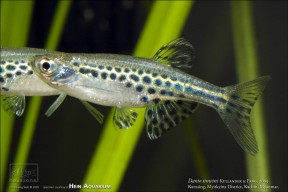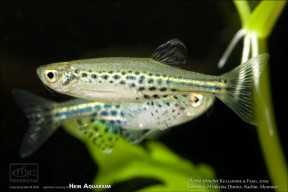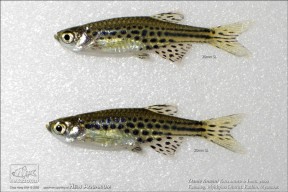Brachydanio tinwini
Gold Ring 'Danio'
SynonymsTop ↑
Danio tinwini Kullander & Fang, 2009
Etymology
Brachydanio: from the Ancient Greek βραχύς (brakhús), meaning ‘short’, and Dhani, a Bengalese vernacular term for small, minnow-like cyprinids.
tinwini: named for U Tin Win, friend of the authors, collector and exporter of ornamental fishes from Myanmar.
Classification
Order: Cypriniformes Family: Cyprinidae
Distribution
To date it’s known only from the Mogaung Chaung (Mogaung stream), Myitkyina District, Kachin State, northern Myanmar, the same watershed to which D. choprae is also apparently endemic.
This is a tributary of the Irrawaddy/Ayeyarwady River and although the species is probably endemic to the region the possibility that it’s been collected from other localities for the aquarium trade cannot be discounted.
The full type locality is ‘Stream from Shatrazyut (Sha Da Zup) village, on road from Mogaung to Tanai, 25°54’54″N, 96°39’48″E, Ayeyarwaddy River drainage, Kachin State, Myanmar’.
Myanmar can be considered a centre of diversity for the genus with over ten species, most of which are endemic to the country.
Habitat
No details are available but presumably similar to that of other small members of the genus meaning slower-moving, often marginal sections of well-oxygenated streams and minor rivers.
Maximum Standard Length
A small species measuring just 20 – 30 mm when adult.
Aquarium SizeTop ↑
A group will need an aquarium with base dimensions measuring upwards of 45 ∗ 30 cm.
Maintenance
Looks particularly effective in a heavily-planted arrangement with a darker substrate, and may appear paler in sparsely-decorated set-ups.
We suggest maintaining it in a well-planted aquarium or set-up designed to resemble a flowing river or stream, with a substrate of variably-sized rocks and gravel and some large water-worn boulders.
Additional powerhead(s) or filter outlets can be used to provide flow but torrent-like conditions should be avoided since small danionins tend to occupy calmer stretches and marginal zones in nature.
Driftwood roots, branches and aquatic plants, with hardy genera such as Microsorum, Bolbitis or Anubias ideal since they can be grown attached to the décor, can also be added.
The aquarium must have a very tightly-fitting cover as members of this genus are accomplished jumpers and can fit through surprisingly small gaps.
Water Conditions
Temperature: In Kachin the air temperature varies between 80°F/26.6°C in summer and 60°F/15.5°C in winter. Under aquarium conditions the fish seem most comfortable between 18 – 26 °C.
pH: 6.5 – 7.5
Hardness: The water in northern Myanmar is typically soft so aim for somewhere within the range 18 – 90 ppm.
Diet
Almost certain to prey chiefly on insects and their larvae in nature as with most danionins.
In the aquarium it’s a largely unfussy feeder and will accept most foods. A good quality dried product can be used as the staple diet but this should be supplemented with regular meals of small live and frozen fare such as bloodworm, Daphnia, Artemia, etc. for the fish to show the best colouration and conditioning.
Behaviour and CompatibilityTop ↑
This species is generally peaceful making it an ideal resident of the well-furnished community tank although its small adult size must be accounted for.
As it places no special demands in terms of water chemistry it can be combined with many of the most popular fish in the hobby including other small cyprinids as well as tetras, livebearers, rainbowfishes, anabantoids, catfishes and loaches.
As always when selecting a compatible community of fish proper research is essential, however, and its small adult size must be taken into account.
A community based around fishes from Kachin could also make an interesting display with other species from the area including Celestichthys choprae, Brachydanio kyathit, Pethia erythromycter, P. didi, Acanthocobitis zonalternans, Lepidocephalichthys guntea, Badis corycaeus and Dario hysginon.
It’s a schooling species by nature and should be maintained in a group of at least 8-10 specimens.
Maintaining it in decent numbers will not only make the fish less nervous but result in a more effective, natural-looking display while males will also exhibit their best colours as they compete with one other for female attention.
Sexual Dimorphism
Sexually mature females are usually rounder-bellied and a little larger than males.
The differences are especially clear when the fish are in spawning condition as the males intensify in colour and the females fill with eggs.
Reproduction
Like many small cyprinids this species is an egg-scattering spawner that exhibits no parental care.
When the fish are in good condition they will spawn often and in a densely-planted, mature aquarium it’s possible that small numbers of fry may start to appear without intervention.
However if you want to increase the yield of fry a slightly more controlled approach is required.
The adult group can still be conditioned together but one or more smaller, say 10-15 litre, containers should also be set up and half-filled with water.
These should be very dimly lit and the base covered with some kind of mesh of a large enough grade so that the eggs can fall through it but small enough so that the adults cannot reach them.
The widely available plastic ‘grass’-type matting can also be used and works very well; alternatively filling much of the tank with Java moss or other fine-leaved plant can also yield good results.
The water itself should be very soft, of slightly acidic to neutral pH with a temperature towards the upper end of the range suggested above.
A small power filter can be added initially and this should be positioned so that the flow is directed down the full length of the tank; alternatively simply install a mature sponge-type filter.
When the adult fish are well-conditioned and the females appear full of eggs one or two pairs should then be introduced to each container.
Spawning can be initiated by adding small amounts of cool water every few hours in such a way that the tank is gradually topped up and feeding small amounts of live and frozen foods.
The pair should spawn the following morning. The easiest and quickest way to tell is simply to look at the female. If the fish have spawned she will be noticeably slimmer.
The adults will eat any eggs they find and are best removed after a couple of days at which point the power filter should be switched for a mature sponge-type unit in order to avoid fry being sucked into the mechanism.
Incubation is temperature-dependant to an extent but usually takes between 24 and 36 hours with the young free-swimming a few days later.
Initial food should be Paramecium or a proprietary dry food of sufficiently small (5-50 micron diameter) grade, introducing Artemia nauplii, microworm, etc., once the fry are large enough to accept them.
NotesTop ↑
This species was first seen in the aquarium trade during 2003 but became more widely available in 2005.
It’s been traded under various names including ‘Danio sp. TW02′, ‘D. sp. fire ring’, ‘D. sp. gold ring’, ‘D. sp. spotted’ and ‘D. sp. Burma’. It’s similar to B. kyathit and B. nigrofasciata but can be told apart by its smaller size, spotted (vs. striped) patterning in the unpaired fins and much shorter barbels.
Adult size is comparable to B. nigrofasciata, and the two may be closely-related given they share other features such as similar barbel length (plus some additional merisitic counts), absent lateral line and spotted pelvic fins.
The two are easy to tell apart, however, since in B. tinwini the P+1 stripe is composed of a series of spots (vs. solid), it possesses an indistinct P+2 stripe (vs. absent) and it possesses spot-like markings in the caudal and dorsal fins (vs. no spots in caudal and dorsal fins).
It also shares a dorsal-fin ray count of 6½ with B. aesculapii, setting these two apart from all other congeners which have a minimum of 7½.
In recent years it’s become commonplace to refer to the stripes on the body and fins of danionins as follows:
– P stripe: or “pigment stripe” is the central, dark, lateral stripe on the body which extends into the caudal-fin in some species. Stripes above it are numbered P+1, P+2, etc. and those beneath P-1, P-2, P-3.
– A stripe: the central stripe on the anal-fin; the proximal stripe (above it) is A+1 and the distal stripe (beneath) A-1.
– D stripe: The submarginal dorsal-fin stripe.
Following Fang (2003) Brachydanio spp. are characterised by the presence of an A stripe on the anal-fin and two or more P stripes on the caudal, plus some internal characteristics such as enlarged nasal lamellae.
The genus has undergone some significant taxonomic reshuffling in recent years following the publication of a series of phylogenetic studies.
Older, molecular, phylogenies tended to agree that it represented a monophyletic group consisting of two major clades; the ‘Danio devario‘ group containing the larger, deeper-bodied species and the ‘D. rerio‘ clade comprising the smaller, slimmer fish.
However in 2003 Fang conducted a more detailed study based on morphological characters which included members of other related genera, and the results suggested for the first time that the genus Danio as previously considered represents a polyphyletic grouping, i.e., not all members derived from a single common ancestor.
The genus name Devario was suggested for the larger species with Danio being applied only to the smaller fish (with the exception of the type species, D. dangila which can grow to around 89 mm SL). Recent molecular studies by Mayden et al. (2007) and Fang et al. (2009) resulted in further changes, with the latter study considering the genus Danio to be composed of three subclades. These were subsequently split into distinct genera by Kottelat (2013), as follows:
The former species D. erythromicron, D. margaritatus, D. choprae and D. flagrans are grouped together in the revalidated genus Celestichthys Roberts, 2007. These exhibit unique body patterning consisting of vertical bars (C. erythromicron, C. choprae, C. flagrans) or light spots (C. margaritatus) and possess either very short barbels or none at all.
The genus Danio contains only the type species, D. dangila, separated on the basis of its larger size and the shape of the caudal-fin, which in adults is only slightly emarginate or even truncate in shape, a feature it shares only with Tinca tinca (the common tench) among other cyprinids.
The remaining species, of which B. rerio is thought to be the most ancient, are included in the revalidated genus Brachydanio Weber & de Beaufort, 1916.
References
- Kullander, S. O. and F. Fang, 2009 - Ichthyological Exploration of Freshwaters 20(3): 223-228
Danio tinwini, a new species of spotted danio from northern Myanmar (Teleostei: Cyprinidae). - Conway, K. W., W.-J. Chen and R. L. Mayden, 2008 - Zootaxa 1686: 1-28
The 'Celestial Pearl danio' is a miniature Danio (s.s) (Ostariophysi: Cyprinidae): evidence from morphology and molecules. - Fang, F., 2003 - Copeia 2003(4): 714-728
Phylogenetic Analysis of the Asian Cyprinid Genus Danio (Teleostei, Cyprinidae). - Fang, F., M. Norén, T. Y. Liao, M. Källersjö and S. O. Kullander, 2009 - Zoologica Scripta 38(1): 1-20
Molecular phylogenetic interrelationships of the south Asian cyprinid genera Danio, Devario and Microrasbora (Teleostei, Cyprinidae, Danioninae). - Kottelat, M., 2013 - The Raffles Bulletin of Zoology Supplement 27: 1-663
The fishes of the inland waters of southeast Asia: a catalogue and core bibiography of the fishes known to occur in freshwaters, mangroves and estuaries. - Mayden, R. L., K. L. Tang, K. W. Conway, J. Freyhof, S. Chamberlain, M. Haskins, L. Schneider, M. Sudkamp, R. M. Wood, M. Agnew, A. Bufalino, Z. Sulaiman, M. Miya, K. Saitoh, and S. He, 2007 - Journal of Experimental Zoology, Molecular Development and Evolution 308B: 642–654
Phylogenetic relationships of Danio within the order Cypriniformes: a framework for comparative and evolutionary studies of a model species.






October 8th, 2014 at 11:19 am
I have kept this species in several different tanks over the course of three years. I’ve kept them in schools of twelve and six. Behavior was extremely similar in both school sizes. When I first kept them, I had them in a 55 gallon danio species tank. My largest danio (the Lake Inle danio) was around 3.5″. When I got my first batch, they were barely more than .5″ long, but they still happily got along with every species, including schooling with them.
In my experience, they are a tightly schooling danio, more so than most. They make excellent dither fish and have drawn my chilli rasbora, emerald dwarf rasbora, and celestial pearl danio permanently out of hiding. They are small fish with huge personalities.
Mine have never exceeded much more than 1″ in length, making them significantly smaller than the dwarf spotted danio (B. nigrofasciata) that I’ve seen and kept.
Mine have spawned readily, but I have never had the resources to save the eggs and raise the fry. My males all have more intensely spotted dorsal and anal fins than my females. I’ve found that when the males are in breeding condition, their fins are edged in gold.
This is one of my favorite fish I have ever kept and I appreciate that they are now readily available in my area.